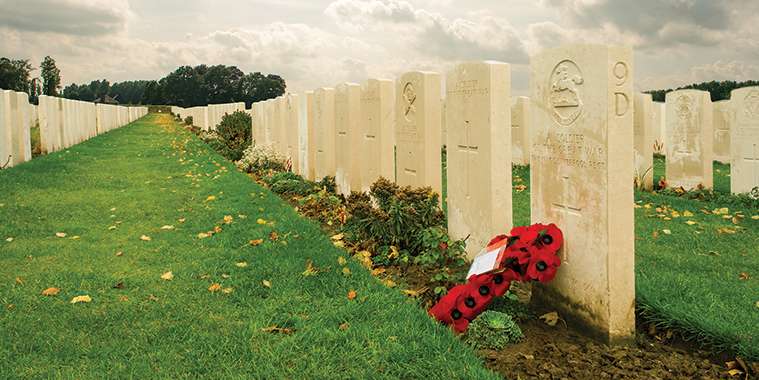Each November, poppies bloom on the lapels and collars of millions of Canadians as they remember the fallen who fought for the freedoms we enjoy today.
While the significance of the poppy can be traced back to the Napoleonic Wars in the 19th century, over 110 years before being adopted in Canada, the poppy is the enduring symbol of remembrance of the First World War. It is strongly linked with Armistice Day (November 11), but the poppy’s origin as a popular symbol of remembrance lies in the landscapes of the First World War.
Poppies were a common sight, especially on the Western Front, which was a 400-plus mile stretch of land weaving through France and Belgium from the Swiss border to the North Sea. It was the decisive front during the First World War. Poppies flourished in the soil churned up by the fighting and shelling. Scientists attributed the poppy’s growth to soils becoming enriched with lime from the rubble left by the war. The red poppy provided Canadian doctor Lieutenant Colonel John McCrae with inspiration for his poem “In Flanders Fields”, which he wrote while serving on the front lines in Ypres in 1915.
The poem was first published in Punch, having been rejected by The Spectator. Within months, this poem came to symbolize the sacrifices of all who were fighting in the First World War.
In 1918, in response to McCrae’s poem, American humanitarian Moina Michael wrote, “And now the Torch and Poppy Red, we wear in honour of our dead…” She campaigned to make the poppy a symbol of remembrance of those who had died in the war.
Today, the poem continues to be a part of Remembrance Day ceremonies in Canada and other countries throughout the world.
In Flanders Fields
In Flanders Fields the poppies blow
Between the crosses row on row.
That mark our place; and in the sky
The larks, still bravely singing, fly
Scarce heard amid the guns below.
We are the Dead. Short days ago
We lived, felt dawn, saw sunset glow,
Loved, and were loved,
and now we lie
In Flanders fields.
Take up our quarrel with the foe:
To you from failing hands we throw
The torch; be yours to hold it high.
If ye break faith with us who die
We shall not sleep,
though poppies grow
In Flanders fields.
How to wear a poppy
Wearing a poppy is a personal expression of remembrance, and how someone chooses to wear a poppy is always an individual choice. Various charities sell poppies in different colours, each with their own meaning but all to commemorate the losses of war. White poppies, for example, symbolise peace without violence, and purple poppies are worn to honour animals killed in conflict. In WWI, over eight million horses and countless donkies and mules died.
The poppy should be worn with respect on the left side, over the heart. The lapel poppy is a sacred symbol of remembrance and should not be affixed with any pin that obstructs the poppy.
When to wear a poppy
The lapel poppy should be worn during the remembrance period, from the last Friday in October until November 11. The Royal Canadian Legion also encourages the wearing of poppies at funerals of veterans, and for any commemorative event such as a memorial service, or the anniversary of the Battle of Vimy Ridge. As well, it is not inappropriate to wear a poppy during other times to commemorate fallen veterans, but it is an individual choice to do so.
How to remove a poppy
Poppies may be worn throughout the remembrance period, including in the evening after the Remembrance Day ceremony. Some choose to remove their poppy at the end of the day on November 11. Some choose to remove their poppy at the conclusion of the ceremony and place their poppy on a cenotaph or on a wreath as a sign of respect. This has become a poignant tradition each year at the National Remembrance Day Ceremony in Ottawa as thousands of poppies are placed on the Tomb of the Unknown Soldier.
When a poppy is removed, it should be stored appropriately or it may be disposed of respectfully. We encourage anyone who finds a poppy that has fallen to the ground to pick it up and brush it off so that it can be kept or disposed of respectfully.
Every year in Canada, The Royal Canadian Legion conducts the Poppy Campaign — along with thousands of their members who volunteer from coast to coast to coast — to raise funds in support of veterans and their families.
While poppies are always distributed freely, The Royal Canadian Legion gratefully accepts donations to the Poppy Fund, which directly supports Canada’s veterans and their families in need. These generous donations are invaluable to their organization. You can visit the website at legion.ca for more information about the essential services they offer.
The Legion also operates a store at poppystore.ca where you can buy poppy jewelery, bags, shirts and even face masks.
Wear your poppy proudly this Remembrance Day in honour of those both past and present who have sacrificed for our freedoms.



